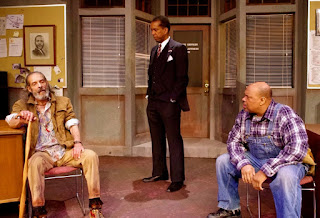If
you’ve ever felt a bit sorry for those people in an orchestra who are forced to
sit still and play their instruments, you’ll be happy to know they’ve been set
free in this remarkable production of Amadeus
by Peter Shaffer. This is a film of a live stage production at the Royal National Theatre in London, presented by the Cedar-Lee Theatre.
As
envisioned by director Michael Longhurst, the 20 orchestra members from the Southbank Sinfonia are pretty
much constantly in motion, responding to lines spoken by the actors, serving as
crowds of people, and otherwise walking and playing. They must have had a ball.
But
it’s not just a gimmick, as this moveable feast of musicians amplifies the
energy and accessibility of Mozart’s music as Shaffer’s tale develops. Although
the title employs the famous composer’s middle name, this play is really a deep
plunge into the psyche of Antonio Salieri, the self-confessed mediocre composer
who is a favorite of the court of Emperor Joseph II.
But
once the young, brash and profane Mozart appears, Salieri’s life is changed
forever, and not in a good way. While envying Mozart’s gift with music, Salieri
plots to destroy the composer who has the talent that the older man can only
dream of having. This drama is all super-fictionalized by Shaffer, but it provides a
wonderful platform to explore the roots of genius and the tragedy of a dream
denied.
This
film of a live stage show isn’t everything you get from an actual experience in
the theater, but the production is quite breathtaking nonetheless. The scenes
change with smooth precision, deftly altering the visual landscape as the actors
and musicians move amongst each other without missing a beat. And the cameras treat you to closeups.
As Salieri, Lucian Msamati is powerful as a wounded and
tormented man, imploring God to explain why he is forced to watch Mozart create
one masterpiece after another. Even though Salieri is the one who is showered
with monetary and material riches, his jealousy burns with fervor.
Adam
Gillen makes Mozart a thoroughly repellent fellow, which is as it should be. He
is actually more irritating than Tom Hulce was in the movie version, and that
helps clarify the conflict between the two music makers. They are surrounded by
exceptional actors and, as mentioned, the orchestra members who are physically
merged into virtually every moment of the production.
This
production of Amadeus is part of the
ongoing series at the Cedar-Lee Theatre, called National Theatre Live,
presenting films of live stage performances from the Royal National Theatre in London. There is only
one more showing of this play, this coming Sunday at 11 AM, so make a note.
Amadeus
Sunday,
February 26, 11 AM at the Cedar-Lee Theatre, 2163 Lee Road, Cleveland Hts.
Tickets are $20, 440-528-0355.






